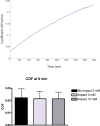Genipin crosslinking decreases the mechanical wear and biochemical degradation of impacted cartilage in vitro
- PMID: 27584857
- PMCID: PMC5518482
- DOI: 10.1002/jor.23411
Genipin crosslinking decreases the mechanical wear and biochemical degradation of impacted cartilage in vitro
Abstract
High energy trauma to cartilage causes surface fissures and microstructural damage, but the degree to which this damage renders the tissue more susceptible to wear and contributes to the progression of post-traumatic osteoarthritis (PTOA) is unknown. Additionally, no treatments are currently available to strengthen cartilage after joint trauma and to protect the tissue from subsequent degradation and wear. The purposes of this study were to investigate the role of mechanical damage in the degradation and wear of cartilage, to evaluate the effects of impact and subsequent genipin crosslinking on the changes in the viscoelastic parameters of articular cartilage, and to test the hypothesis that genipin crosslinking is an effective treatment to enhance the resistance to biochemical degradation and mechanical wear. Results demonstrate that cartilage stiffness decreases after impact loading, likely due to the formation of fissures and microarchitectural damage, and is partially or fully restored by crosslinking. The wear resistance of impacted articular cartilage was diminished compared to undamaged cartilage, suggesting that mechanical damage that is directly induced by the impact may contribute to the progression of PTOA. However, the decrease in wear resistance was completely reversed by the crosslinking treatments. Additionally, the crosslinking treatments improved the resistance to collagenase digestion at the impact-damaged articular surface. These results highlight the potential therapeutic value of collagen crosslinking via genipin in the prevention of cartilage degeneration after traumatic injury. © 2016 Orthopaedic Research Society. Published by Wiley Periodicals, Inc. J Orthop Res 35:558-565, 2017.
Keywords: articular cartilage; collagen; crosslinking; genipin; post-traumatic osteoarthritis.
© 2016 Orthopaedic Research Society. Published by Wiley Periodicals, Inc.
Conflict of interest statement
Conflicts of interest: None.
Figures





Similar articles
-
A Photochemical Crosslinking Approach to Enhance Resistance to Mechanical Wear and Biochemical Degradation of Articular Cartilage.Cartilage. 2022 Jul-Sep;13(3):19476035221093064. doi: 10.1177/19476035221093064. Cartilage. 2022. PMID: 35819016 Free PMC article.
-
Genipin crosslinking of cartilage enhances resistance to biochemical degradation and mechanical wear.J Orthop Res. 2015 Nov;33(11):1571-1579. doi: 10.1002/jor.22939. Epub 2015 May 18. J Orthop Res. 2015. PMID: 25939430 Free PMC article.
-
Evaluation of genipin for stabilization of decellularized porcine cartilage.J Orthop Res. 2017 Sep;35(9):1949-1957. doi: 10.1002/jor.23483. Epub 2017 Mar 24. J Orthop Res. 2017. PMID: 27859554 Free PMC article.
-
Relationship among biomechanical, biochemical, and cellular changes associated with osteoarthritis.Crit Rev Biomed Eng. 2001;29(4):373-91. doi: 10.1615/critrevbiomedeng.v29.i4.10. Crit Rev Biomed Eng. 2001. PMID: 11822479 Review.
-
Physical properties imparted by genipin to chitosan for tissue regeneration with human stem cells: A review.Int J Biol Macromol. 2016 Dec;93(Pt B):1366-1381. doi: 10.1016/j.ijbiomac.2016.03.075. Epub 2016 Apr 19. Int J Biol Macromol. 2016. PMID: 27106590 Review.
Cited by
-
Regeneration of skeletal system with genipin crosslinked biomaterials.J Tissue Eng. 2020 Nov 29;11:2041731420974861. doi: 10.1177/2041731420974861. eCollection 2020 Jan-Dec. J Tissue Eng. 2020. PMID: 33294154 Free PMC article. Review.
-
Decreased SIRT1 Activity Is Involved in the Acute Injury Response of Chondrocytes to Ex Vivo Injurious Mechanical Overload.Int J Mol Sci. 2023 Mar 30;24(7):6521. doi: 10.3390/ijms24076521. Int J Mol Sci. 2023. PMID: 37047494 Free PMC article.
-
Exogenous Collagen Crosslinking is Highly Detrimental to Articular Cartilage Lubrication.J Biomech Eng. 2024 Jul 1;146(7):071001. doi: 10.1115/1.4064663. J Biomech Eng. 2024. PMID: 38323667 Free PMC article.
-
Genipin does not reduce the initiation or propagation of microcracks in collagen networks of cartilage.Osteoarthr Cartil Open. 2022 Jan 11;4(1):100233. doi: 10.1016/j.ocarto.2022.100233. eCollection 2022 Mar. Osteoarthr Cartil Open. 2022. PMID: 36474465 Free PMC article.
-
A Photochemical Crosslinking Approach to Enhance Resistance to Mechanical Wear and Biochemical Degradation of Articular Cartilage.Cartilage. 2022 Jul-Sep;13(3):19476035221093064. doi: 10.1177/19476035221093064. Cartilage. 2022. PMID: 35819016 Free PMC article.
References
-
- Buckwalter JA, Martin JA. Sports and osteoarthritis. Curr Opin Rheumatol. 2004;16:634. - PubMed
-
- Buckwalter JA, Brown TD. Joint injury, repair, and remodeling: roles in post-traumatic osteoarthritis. Clin Orthop Relat Res. 2004;423:7. - PubMed
-
- Haut RC, Ide TM, De Camp CE. Mechanical responses of the rabbit patello-femoral joint to blunt impact. J Biomech Eng. 1995;117:402. - PubMed
-
- Newberry WN, Mackenzie CD, Haut RC. Blunt impact causes changes in bone and cartilage in a regularly exercised animal model. J Orthop Res. 1998;16:348–354. - PubMed
Publication types
MeSH terms
Substances
Grants and funding
LinkOut - more resources
Full Text Sources
Other Literature Sources

